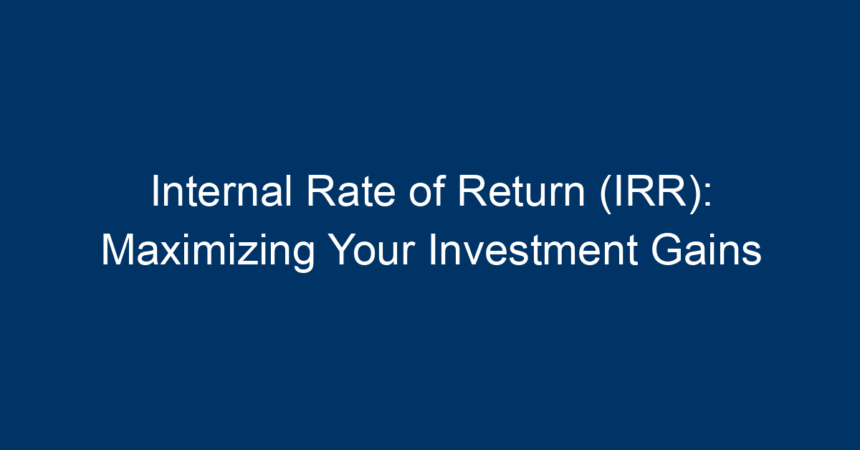When it comes to investing, understanding the metrics that guide your decision-making can make all the difference. One such crucial metric is the Internal Rate of Return (IRR). Whether you’re a seasoned investor or just starting your journey, grasping IRR can help you evaluate your potential investments effectively. In this article, we will explore what IRR is, its significance, how to calculate it, and ways to maximize your investment gains using this powerful metric.
What is Internal Rate of Return (IRR)?
The Internal Rate of Return (IRR) is a financial metric used to assess the profitability of potential investments or projects. It represents the discount rate at which the net present value (NPV) of cash flows from the investment equals zero. In simpler terms, the IRR is the rate at which an investment breaks even.
Why is IRR Important?
Understanding the IRR is crucial for several reasons:
- Investment Comparison: IRR allows investors to compare different investment opportunities easily. A higher IRR signifies a more lucrative investment.
- Decision-Making Tool: For businesses, calculating IRR can inform investment decisions, allowing companies to choose projects that align with their financial goals.
- Risk Assessment: IRR can help gauge the risk associated with an investment. A high IRR might indicate a high-risk project that could either yield significant returns or lead to substantial losses.
How to Calculate Internal Rate of Return (IRR)
Calculating IRR may sound complex, but it can be done using a straightforward formula. However, since the IRR involves solving for the discount rate that makes the NPV zero, financial calculators or software tools like Excel are typically used for this purpose.
The Formula for IRR
The formula for calculating NPV is:
[
NPV = \sum \frac{C_t}{(1 + r)^t} – I
]
Where:
- (C_t) = Cash inflow during the period (t)
- (r) = Discount rate (IRR)
- (t) = Time period
- (I) = Initial investment
To find IRR, solve for (r) in the equation above where (NPV = 0).
Using Excel to Calculate IRR
Microsoft Excel simplifies this process with the IRR function. Here’s how to use it:
- List your cash flows in a column, starting with the initial investment (which should be negative).
- Use the formula
=IRR(range)where “range” corresponds to your cash flow data. - Excel will return the IRR as a percentage.
Example Calculation
Imagine you invest $10,000 in a project expected to generate the following cash flows over four years:
- Year 1: $3,000
- Year 2: $4,000
- Year 3: $5,000
- Year 4: $6,000
Using the IRR function in Excel would yield a rate that you can compare against other investment opportunities.
Maximizing Your ROI with IRR
Now that you understand how to calculate the Internal Rate of Return (IRR), let’s look at practical strategies for maximizing your investment gains using this metric.
1. Select Projects with Higher IRR
When faced with multiple investment options, prioritize those with the highest IRRs. This strategy increases the likelihood of achieving greater returns. However, vet these projects for associated risks to ensure that pursuing high IRR opportunities will not jeopardize your overall portfolio.
2. Reinvest Cash Flows
Reinvesting cash flows from profitable projects can exponentially boost your returns. By continually pouring your returns back into high IRR projects, you harness the power of compounding, leading to amplified growth over time.
3. Improve Cash Flow Timing
Adjusting the timings of cash flows can significantly impact IRR. For instance, receiving cash flows sooner enhances IRR due to the time value of money. Explore opportunities to expedite cash inflow, whether through aggressive branding, sales strategies, or incentive programs that encourage early payments.
4. Mitigate Risks
Investments with high IRRs often come with equally high risks. Assess the risk factors associated with each investment before diving in. Conduct thorough due diligence, including market research and competitive analysis, to identify potential pitfalls.
5. Monitor and Adjust Regularly
The investment landscape is dynamic. Regularly reviewing your projects and their IRR helps you stay aligned with your financial goals. If an investment isn’t performing as anticipated, consider reallocating your resources to more lucrative opportunities.
Limitations of Internal Rate of Return (IRR)
While the Internal Rate of Return (IRR) is a valuable tool, it does come with limitations:
- Multiple IRRs: Projects with alternating cash flow patterns may yield multiple IRRs, making the decision-making process convoluted.
- Assumption of Reinvestment Rates: IRR assumes that cash flows are reinvested at the same rate, which might not be practical in real-life scenarios.
- Ignoring Scale: IRR does not consider the size of the investment. A smaller project may have a higher IRR but offer less overall profit compared to a larger project with a lower IRR.
Conclusion: Actionable Insights for Investors
Understanding the Internal Rate of Return (IRR) can fundamentally alter your investment strategy. By mastering this metric, you gain the power to compare investments effectively, make informed decisions, and ultimately maximize your financial returns.
Key Takeaways:
- Always calculate IRR when evaluating investment opportunities.
- Reinvest cash flows to take advantage of compounding.
- Regularly assess your investments and pivot when needed.
- Stay aware of IRR’s limitations to avoid misinterpretation.
By following these actionable insights, you can position yourself for greater investment success and make the most out of the opportunities available in your financial landscape. Remember, the journey to investment mastery starts with understanding the numbers—let IRR be your guide.




